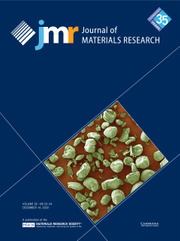Article contents
Modeling of wave configuration during electrically ignited combustion synthesis
Published online by Cambridge University Press: 31 January 2011
Abstract
A model was developed to study the process of current-ignited combustion synthesis. In this process, Joule heating raises the temperature to the ignition point, at which the sample reacts to form a product. Two material systems were modeled: the synthesis of SiC and MoSi2. It was found that the mode of combustion is a function of the size (radius) of the sample. The anticipated volume combustion mode was only evident in small samples. At higher values of the radius, the mode becomes wavelike (selfpropagating high-temperature synthesis) in nature. The transition from volume to wave combustion mode also depended on the properties of the material. The results are interpreted in terms of thermal conductivity and heat-transfer conditions.
Information
- Type
- Articles
- Information
- Copyright
- Copyright © Materials Research Society 2001
References
REFERENCES
- 9
- Cited by

